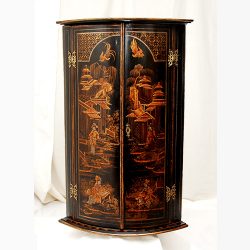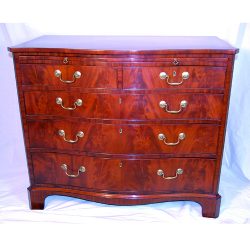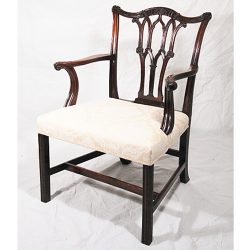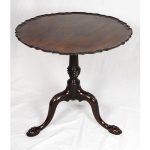Chippendale and all that
By Hannah Crouthamel on Jul 14 in Furniture Designers
Thomas Chippendale – Background
Born in 1718, Chippendale became a master carver and cabinet maker at an early age.  Gifted with a rare eye for design and technique, his workshop in London became a highly successful undertaking. In 1754 he published the first edition of The Gentleman & Cabinet-Maker’s Director. This chronicled tastes of the moment and his designs in particular.
Gifted with a rare eye for design and technique, his workshop in London became a highly successful undertaking. In 1754 he published the first edition of The Gentleman & Cabinet-Maker’s Director. This chronicled tastes of the moment and his designs in particular.
It was so popular that a second edition was printed the following year and a third edition with more plates and up to date revisions in 1762. Most believe The Director, as it became to be known, was the most important book of furniture design published in the 18th century; it dominated design in England and her colonies through much of the century and, in fact, Chippendale’s designs are still being reproduced 250 years later. His influence was felt not only through The Director, but from the furniture that his workshops built and placed in the grand homes of London as well as in country mansions. He trained dozens of cabinetmakers, many of whom later established their own shops in England and in America (very likely some of the cabinetmakers who made furniture in Philadelphia, were trained in his London shop).
Design elements in Chippendale’s lexicon
Chippendale influenced and built on evolving tastes in the 18th century. Whereas early Georgian furniture was quite heavy, Chippendale  used his extraordinary carving abilities to lighten and lift the rather ponderous George I designs. He explored the versatility of a ball and claw foot; he turned solid chair splats into carved and pierced works of art; pedestals for tables were now designed with dramatically carved feet, knees and stems. The carved acanthus leaf became a signature Chippendale detail that showed up in furniture and mirrors.
used his extraordinary carving abilities to lighten and lift the rather ponderous George I designs. He explored the versatility of a ball and claw foot; he turned solid chair splats into carved and pierced works of art; pedestals for tables were now designed with dramatically carved feet, knees and stems. The carved acanthus leaf became a signature Chippendale detail that showed up in furniture and mirrors.
Chippendale’s design was heavily influenced by ‘outside’ designs. For example, the French court of Louis XV created a buzz for the elegance of the Rococo style. In response, Chippendale’s designs incorporated delicate cabriole carved legs, curved sofas, elaborate commodes, putti,drape and dolphin carved candlestands and myriad other designs reminiscent of the continental taste – all of these and more were included in The Director.
Later with the ongoing exploration of China, Chippendale was inspired to incorporate the design motifs of the Far East.This body of work became known as Chinese Chippendale. Chinese fretwork became an important detail; chinoiserie painted decoration was utilized in all manner and forms of furniture from bureau bookcases, to chairs, to dressing tables.
Later the Gothic period, was romanticized and details from gothic churches found their way into Chippendale’s furniture – the gothic arch appeared in chair backs, trefoils were carved into fretwork, the shape of Gothic cathedral windows was replicated in the glazing of bookcases.
into Chippendale’s furniture – the gothic arch appeared in chair backs, trefoils were carved into fretwork, the shape of Gothic cathedral windows was replicated in the glazing of bookcases.
In the 1760’s Chippendale used the Classic period for inspiration. He based it on Robert Adam’s work. The columns, pediments and balance inherent in Greek and Roman design were reinterpreted and found their way into his furniture. Classical columns were utilized to lend architectural gravity to the corners of chests of drawers or bookcases; broken pediments surmount tall case pieces of furniture; and Greek key friezes were found below cornices.
Flexibility of Design
Chippendale’s designs were eminiently flexible; they could be made more or less elaborate, some of the design patterns were translated to more country woods like English deal (pine) or oak, rather than mahogany which was the dominant timber that he used. His work could be made simpler. Instead of having a square leg with blind fretwork carving, a simpler, plain square leg could be employed, or perhaps a molded square leg. When building a chair, i nstead of an elaborately carved pierced back, the shape could remain but carving could be eliminated.
nstead of an elaborately carved pierced back, the shape could remain but carving could be eliminated.
In the 18th century when one went to a local cabinetmaker to have a chair made, it depended on one’s budget or need as to how elaborate to make it. Mahogany was more expensive than oak, extensive carving was more expensive than no carving or ‘outline’ carving.
Chippendale’s Director showed proportionality, how to create a visually lovely column, but as is the case with most 18th century design books, he assumed that the cabinet maker who was going to be using this book as a pattern, knew how to build furniture, understood proportionality and had the ability to copy from a picture. He didn’t give a recipe for ‘how’ to carve a leg or form a leaf. But a fine craftsman could look at Chippendale’s drawings and replicate or at least be inspired by them. He had pages of ‘frets’ which gave patterns for intricate carvings that could be used on legs, or under cornices or transformed into railings or fences. The pages of details that he employed could be utilized in a variety of mediums.  His designs were inspirational to other trades such as metalware or needlework.
His designs were inspirational to other trades such as metalware or needlework.
Summary
Chippendale’s designs are visually strong and fluid. For example, he emphasized carving over inlay, wood detailing rather than attaching ormolu mounts.
Strength was also created by adding architectural details (columns are often seen); or square and straight chamfered legs with blind fretwork carving, molded or plain edges; or impressive bracket bases for bookcases, chests and desks.
Grace was personified in cabriole legs with carved feet and knees. However, Chippendale never limited his options; indeed he did on occasion use ormolu mounts; sometimes he added inlay to his designs. His legacy, however, is dominated by carving and form.

